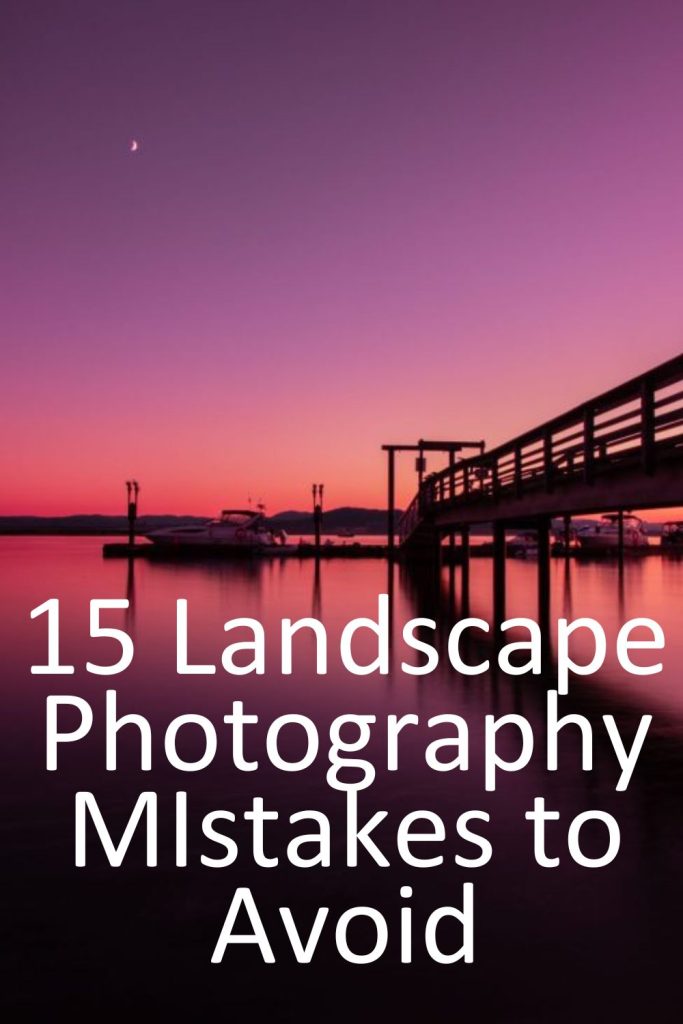
Landscape photography mistakes happen to all of us, especially in the beginning. From forgetting your tripod to choosing the wrong white balance, these slip-ups can turn an awe-inspiring moment into a missed opportunity.
I’ve made just about every mistake in the book (and probably invented a few new ones), which is why I want to share this guide with you.
If you’re just getting started in landscape photography or even if you’ve been at it a while, avoiding these 15 common issues will help you take more intentional, connected, and compelling images. Let’s dive in.
Practice Makes Perfect
Top Landscape Photography Mistakes
These landscape photography mistakes are incredibly common…but they’re also completely fixable. I’ve made every one of them at some point in my journey, and honestly, they’ve all helped me grow. The goal isn’t to be perfect; it’s to be intentional.
15 Things to Avoid when Capturing Landscape Photos
- Ignoring light
- Not Using a tripod
- Forgetting to check the horizon
- Centering the horizon
- Not Paying attention to White Balance
- Failing to Plan
- Using the wrong lens
- Over Editing
- Leaving out a Focal Point
- Overlooking the Foreground
- Bad composition
- Poor weather prep
- Shooting in Auto Mode
- Leaving your filters at home
- Not practicing enough
Discover Your Next Journey – These Tours are designed for people who connect with light and landscape.
Ignoring the Light
Shooting at high noon or in flat light because it’s convenient (this usually works with black and white only).
The solution: Start planning your outings around golden hour (shortly after sunrise or before sunset) or blue hour (right before sunrise or after sunset). Light is the language of photography, and soft, directional light adds shape, depth, and mood to a scene.
Not Using a Tripod
Handholding your camera for every shot, even in low light is a recipe for images that are not sharp. Some of the newer cameras have amazing in camera stabilization up to a certain point.
If you own a newer camera, it would be worth it to experiment in low light to see how far you can push handheld images before they become softer than you’d like. I find with my R5 that I can do a ton of focus stacking before I need to use my tripod.
The solution: Use a sturdy tripod to keep your images sharp and allow for longer exposures, especially in golden hour, blue hour, or night photography. It’s also essential for focus stacking and HDR blending.
Forgetting to Check the Horizon
Crooked horizons can throw off the balance of an otherwise great photo. Levelling off your horizon in post can lead to some unexpected cropping which may create havoc with your composition. Better to master the straight horizon in camera while in the field.
The solution: Use the grid on your camera’s viewfinder or live view screen to keep things level. Fix it in post if needed; but get it right in-camera when you can.
Centering the Horizon Every Time
Placing the horizon dead center regardless of the subject. While this may work for some images such as reflections, usually this composition lacks interest for your audience.
The solution: Use the rule of thirds and other composition guidelines to create interesting compositions. Place the horizon in the top third if the foreground is interesting, or in the bottom third if the sky is dramatic. This creates stronger compositions.
Not Paying Attention to White Balance
Letting your camera choose white balance on auto and ending up with color casts.
The solution: Understand how different white balance settings affect your image. Use a custom Kelvin setting or adjust in post. My white balance guide breaks this down with examples and a chart.
📸Learn for free!
➡️ FREE wallpapers
➡️ DISCOUNTS on future Tours and Tutorials
➡️ TIPS for improving your photography

You can unsubscribe at anytime.
Failing to Plan the Shot
Showing up without knowing what to expect. Fail to plan, plan to fail. While I do plan 90% of my shots, I also leave myself some room to explore the area and create something on the fly.
The solution: Use apps like PhotoPills, The Photographer’s Ephemeris, and weather apps to plan light, tides, moon phases, and compositions. Know where the sun will rise or set and when. You can also use AI to assist you with planning your photo trips, sunset/sunrise shoots, and astro.
Using the Wrong Lens
Only bringing a wide-angle lens or a telephoto and missing opportunities.
The solution: Pack a couple of options. Wide-angle lenses are fantastic for sweeping vistas, but mid range telephotos (up to 200mm) and longer range telephotos are great for compressing scenes and isolating interesting details.
Overediting
Over-saturating colors, crushing blacks, or pushing clarity to the extreme. Also, using the old school HDR method and frying everything in the image to a crisp (like bacon!).

The sky is overprocessed in this image and at the beginning of my photo journey, it was a good image.
However, I look back at it now and cringe a bit.
The solution: Aim for balance. Let the natural beauty of the scene shine. Use post processing software to enhance, not overwhelm, your images. Less is more.
Leaving Out a Focal Point
A beautiful scene with no subject to anchor the viewer’s eye.
The solution: Find a strong foreground element such as rock, a tree, a reflection, a path, a river, etc. This draws the viewer in, provides context, and gives your image purpose.
Overlooking the Foreground
Putting all the visual interest in the sky or background.
The solution: Compose from the ground up. Get low, look for textures, lines, or shapes that lead the viewer’s eye deeper into the scene. This adds dimensionality.
Bad Composition
Snapping the shot without thinking about how it all fits together.
The solution: Slow down. Walk around. Frame deliberately. Use leading lines, balance, and negative space. And remember sometimes breaking the “rules/guidelines” is what makes the shot magical.
Poor Weather Prep
Heading out without checking the weather or dressing properly. Since bad weather makes the best photos, we must dress to take the brunt of it.
The solution: Always check the forecast and bring layers. Some of the best photos happen in moody, stormy conditions—but only if you’re safe and comfortable enough to capture them.
Shooting Only in Auto Mode
Letting your camera make all the decisions.
The solution: Learn manual mode or at least aperture priority. Controlling your aperture, shutter speed, and ISO lets you craft the image you envision rather than settling for what your camera thinks is right. To be honest, I know how to use 2 modes: manual and Bulb and never bothered to learn the rest.
Leaving Your Filters at Home
Not using ND or polarizing filters, even when conditions call for them.
The solution: A polarizer can cut glare and make skies pop. ND filters let you create long exposures of moving water or clouds. They’re essential tools, especially for seascapes or rivers.
Not Practicing Enough
Expecting to master everything right away can lead to huge amounts of frustration and disappointment. That photographer that you follow on Instagram with amazing images has probably been shooting for years and has mastered that scene.
The solution: Like any craft, landscape photography takes practice. Get out there often. Review your shots. Learn from what worked and what didn’t. Every image is part of the journey.
After each shoot I do a “lessons learned” and think about the things I could have done differently or better in the creation of my images.
Conclusion
Whether you’re photographing the golden light over a still lake or capturing wild coastal cliffs, slowing down and avoiding these missteps can make the difference between a snapshot and an image that truly resonates.
If you’re feeling overwhelmed, just pick one or two things from this list to focus on during your next shoot. Growth happens in layers, and every step you take brings you closer to expressing the awe and wonder you feel out in nature through your photographs.
📸Learn for free!
➡️ FREE wallpapers
➡️ DISCOUNTS on future Tours and Tutorials
➡️ TIPS for improving your photography

You can unsubscribe at anytime.
- Practice Makes Perfect
- Top Landscape Photography Mistakes
- 15 Things to Avoid when Capturing Landscape Photos
- Ignoring the Light
- Not Using a Tripod
- Forgetting to Check the Horizon
- Centering the Horizon Every Time
- Not Paying Attention to White Balance
- Failing to Plan the Shot
- Using the Wrong Lens
- Overediting
- Leaving Out a Focal Point
- Overlooking the Foreground
- Bad Composition
- Poor Weather Prep
- Shooting Only in Auto Mode
- Leaving Your Filters at Home
- Not Practicing Enough
- Conclusion
- 📸Learn for free!
- 📸Learn for free!






